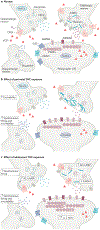Cannabis and synaptic reprogramming of the developing brain
- PMID: 34021274
- PMCID: PMC8445589
- DOI: 10.1038/s41583-021-00465-5
Cannabis and synaptic reprogramming of the developing brain
Abstract
Recent years have been transformational in regard to the perception of the health risks and benefits of cannabis with increased acceptance of use. This has unintended neurodevelopmental implications given the increased use of cannabis and the potent levels of Δ9-tetrahydrocannabinol today being consumed by pregnant women, young mothers and teens. In this Review, we provide an overview of the neurobiological effects of cannabinoid exposure during prenatal/perinatal and adolescent periods, in which the endogenous cannabinoid system plays a fundamental role in neurodevelopmental processes. We highlight impaired synaptic plasticity as characteristic of developmental exposure and the important contribution of epigenetic reprogramming that maintains the long-term impact into adulthood and across generations. Such epigenetic influence by its very nature being highly responsive to the environment also provides the potential to diminish neural perturbations associated with developmental cannabis exposure.
Conflict of interest statement
Competing interests
The authors declare no competing interests.
Figures



References
-
- Berghuis P et al.Hardwiring the brain: endocannabinoids shape neuronal connectivity. Science 316, 1212–1216 (2007). - PubMed
-
This study demonstrates the crucial role of the eCB signalling in axonal guidance and in the formation of accurate synaptic connections.
-
- Buckley NE, Hansson S, Harta G & Mezey E Expression of the CB1 and CB2 receptor messenger RNAs during embryonic development in the rat. Neuroscience 82, 1131–1149 (1998). - PubMed
Publication types
MeSH terms
Substances
Grants and funding
LinkOut - more resources
Full Text Sources
Other Literature Sources

